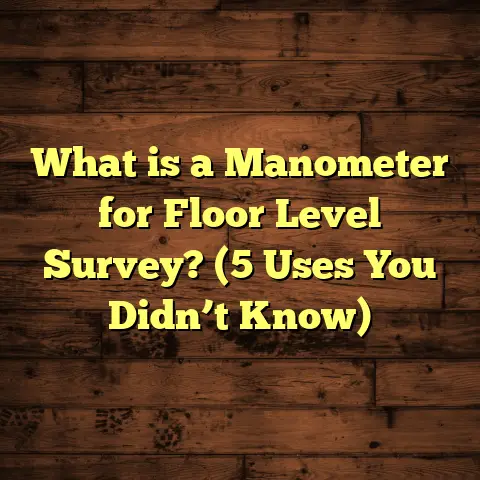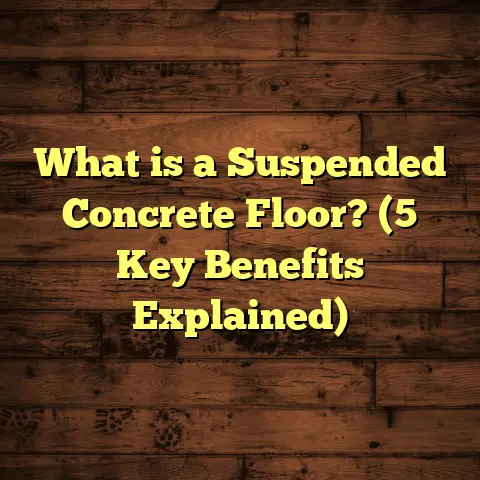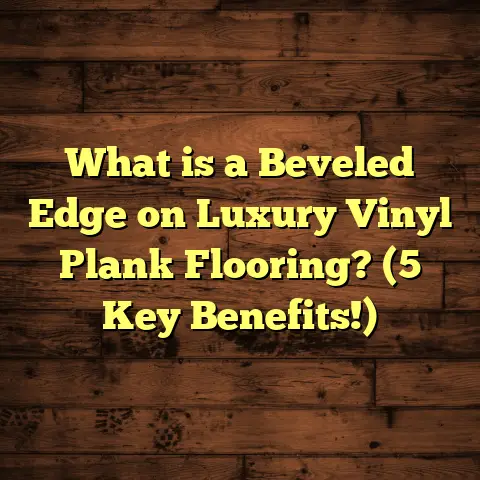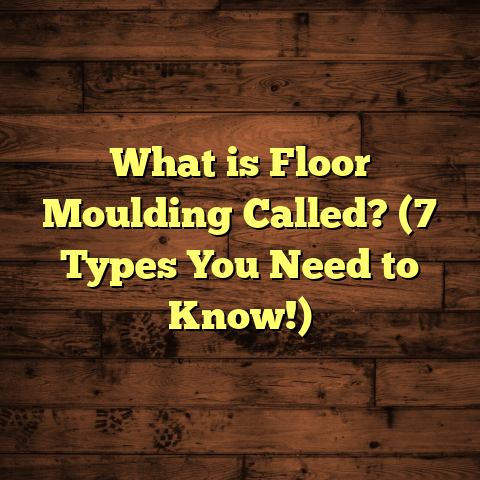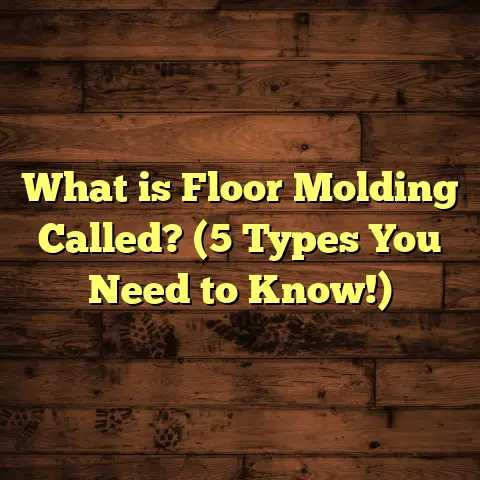What is Bamboo Flooring? (5 Reasons You’ll Love It!)
Have you ever wondered what makes some floors feel both timeless and modern, durable yet eco-friendly? I used to ask myself this a lot when I was searching for the perfect flooring option—not just something that looks good but also fits well with my values and lifestyle. That’s when bamboo flooring caught my attention. Over the years, it has become one of my top recommendations and personal favorites. Let me take you on a thorough journey through what bamboo flooring is all about and why I think you’ll love it as much as I do.
What is Bamboo Flooring?
Bamboo flooring is a type of flooring crafted from bamboo plants—fast-growing grasses that have been used in Asia for centuries in construction, crafts, and furniture. Unlike hardwood floors that come from slow-growing trees, bamboo grows rapidly and regenerates without the need for replanting, making it a highly renewable resource.
When most people hear “bamboo flooring,” they picture planks that look like wood. But the way bamboo is processed can produce very different textures and strengths.
The basic process of making bamboo flooring involves harvesting mature bamboo stalks (usually 5 to 7 years old), stripping them into thin strips or fibers, then treating, compressing, and binding them to form solid planks. There are three main types:
- Horizontal grain: Bamboo strips laid flat, showing the characteristic nodes of the stalk.
- Vertical grain: Bamboo strips stood on edge, giving a smooth, linear grain.
- Strand-woven: Bamboo fibers shredded and compressed under extreme pressure to create a dense, hard plank with a mottled look.
Each type brings unique aesthetics and durability levels.
Why Bamboo is Classified as Flooring
At first glance, you might wonder if bamboo really qualifies as “wood flooring.” Technically, it’s grass-based, but once processed into planks and finished, bamboo behaves much like hardwood floors—it can be sanded, stained, sealed, and installed similarly.
This versatility has helped it grow in popularity worldwide over the last two decades. Bamboo flooring offers an alternative to traditional hardwoods like oak, maple, or cherry that take decades to mature and come with higher environmental costs.
1. Sustainability: Flooring That Supports a Greener Planet
One of the reasons I fell for bamboo flooring early on is its environmental benefit. We hear a lot about sustainability nowadays, but what does that mean when it comes to flooring?
Rapid Growth Cycle
Unlike hardwood trees that may take 20 to 80 years to reach harvestable size, bamboo can mature in just 5 to 7 years. Some species even grow up to 3 feet per day under optimal conditions! This means bamboo can be harvested—and then naturally regrows—much faster than trees can.
Here’s an eye-opening comparison:
| Material | Growth Time to Harvest (Years) |
|---|---|
| Oak | 20-30 |
| Walnut | 40-60 |
| Bamboo | 5-7 |
The quick turnaround reduces deforestation pressure on forests worldwide.
Carbon Sequestration
Bamboo is also impressive at absorbing carbon dioxide from the atmosphere while growing. Studies show bamboo plantations can sequester up to 12 tons of CO₂ per hectare annually. This makes bamboo forests effective carbon sinks.
For homeowners wanting to lower their home’s carbon footprint, choosing bamboo floors means supporting products that help fight climate change.
Minimal Chemical Use
Many bamboo producers treat their strips with natural heat or low-impact chemicals to remove sugars that attract insects. While some low-quality products use formaldehyde-based glues (which I advise against), reputable manufacturers now offer low-VOC adhesives and finishes that are safer for indoor air quality.
This commitment to reducing toxic chemicals makes bamboo flooring better for your health compared to some synthetic flooring options.
My Experience with Eco-Friendly Projects
I worked on a green building project where bamboo flooring was key in earning LEED certification points. The client was thrilled knowing their new flooring came from a renewable resource harvested responsibly. They appreciated being able to trace the product back to sustainable farms certified by organizations like the Forest Stewardship Council (FSC).
If you care about the environment, bamboo lets you enjoy the beauty of natural floors without guilt.
2. Durability: Surprising Strength for Everyday Life
You might ask: “Is something made from grass really strong enough for a busy household?” That was my first doubt too. But after installing several bamboo floors in homes and commercial spaces, my opinion completely changed.
Janka Hardness Scale Comparison
The Janka hardness test measures wood’s resistance to wear and denting. Here’s how strand-woven bamboo stacks up alongside common hardwoods:
| Material | Janka Hardness (lbf) |
|---|---|
| Strand-Woven Bamboo | 1,400 – 1,700 |
| Red Oak | 1,290 |
| Hard Maple | 1,450 |
| Hickory | 1,820 |
Strand-woven bamboo flooring can be harder than traditional hardwoods like oak or maple. This means it resists dents from dropped items or furniture better than many wood floors.
Scratch Resistance
While no floor is scratch-proof, bamboo floors show good resistance under normal wear conditions. Pets’ nails and small abrasions can leave marks but are generally less noticeable on strand-woven or darker-stained planks due to their dense texture.
Water Resistance
Bamboo handles moisture better than many hardwoods but isn’t waterproof. Spills cleaned promptly generally don’t cause damage. Excessive water exposure over time can cause swelling or warping.
Long-Term Performance
From personal projects and client feedback spanning over a decade:
- Bamboo floors installed in high-traffic areas still look great after 10+ years.
- Routine maintenance involves simply cleaning and occasional refinishing.
- Many manufacturers offer warranties of 20-25 years on quality products.
I’ve seen bamboo floors in restaurants and offices hold up exceptionally well under constant foot traffic—a testament to their durability beyond residential use.
3. Design Versatility: Fits Almost Any Style You Want
One thing I love about bamboo is how adaptable it is visually. Whether your style leans modern, rustic, classic, or eclectic, there’s a bamboo floor that will fit beautifully.
Grain Patterns and Textures
The three main grain types each bring distinct looks:
- Horizontal Grain: Shows wide nodes that give a striped effect—great for casual or tropical styles.
- Vertical Grain: Smooth linear grain looks more refined and contemporary.
- Strand-Woven: Dense fibers create a mottled texture that’s rustic yet elegant.
Color Options
Bamboo naturally ranges from pale cream colors to richer honey tones. Manufacturers also stain bamboo floors in various shades:
- Light natural
- Amber
- Carbonized (dark brown from heat treatment)
- Espresso black
Because bamboo takes stain well, you can customize it further for unique looks.
Wide Planks or Narrow Strips?
Bamboo flooring comes in widths from narrow strips (about 3 inches) to wide planks (upwards of 7 inches). Wide planks create a spacious feel in large rooms; narrow strips work well for smaller rooms or traditional layouts.
My Favorite Design Uses
I once installed natural vertical grain bamboo planks in a Scandinavian-style living room painted bright white. The floor’s light color enhanced the airy feel perfectly.
Another client wanted a cozy cabin vibe—so strand-woven dark carbonized bamboo with wide planks completed the rustic look beautifully.
Bamboo floors blend effortlessly with tile backsplashes, stone fireplaces, or painted walls—making them incredibly versatile design partners.
4. Maintenance Made Simple: Less Hassle for You
If you’re anything like me, you want beautiful floors without spending hours cleaning or worrying about damage.
Routine Cleaning Tips
Bamboo floors are simple to keep clean:
- Sweep or vacuum weekly with a soft brush attachment.
- Mop occasionally using a damp mop and pH-neutral cleaner.
- Wipe spills immediately to prevent staining.
Unlike carpet that traps allergens or hardwoods needing special polishes, bamboo requires minimal fuss.
Avoid Harsh Chemicals
Avoid using ammonia-based cleaners or excessive water which can damage finishes over time. Most manufacturers recommend commercial products made specifically for wood or bamboo floors.
Refinishing Bamboo Floors
Solid bamboo floors can be sanded and refinished multiple times—similar to hardwoods—extending their lifespan by decades. Strand-woven floors are denser but still refinishable with proper equipment.
I once refinished a client’s strand-woven floor after 8 years of use; it looked almost new afterward!
Pest Resistance
Because bamboo is treated during manufacturing and naturally low in sugars after treatment, it resists pests better than many woods. This reduces worry about termites or beetles damaging your floor.
5. Cost: Quality Flooring That Won’t Break the Bank
Flooring budgets can make or break a project. Bamboo floors offer great value compared to hardwoods without sacrificing style or performance.
Material Costs
In my experience sourcing materials from multiple suppliers:
- Solid strand-woven bamboo usually costs $5-$7 per square foot.
- Engineered horizontal or vertical grain runs about $3-$5 per square foot.
- Entry-level horizontal grain can be found near $2-$3 per square foot.
Compare this with hardwoods:
- Oak: $6-$12 per square foot.
- Walnut: $8-$15 per square foot.
Bamboo provides an affordable alternative with comparable longevity and appeal.
Installation Costs
Installation typically adds $3-$6 per square foot depending on complexity and region. Bamboo installs similarly to hardwoods—nail-down, glue-down, or floating methods apply.
If you DIY install engineered bamboo planks with click-lock systems, labor costs drop significantly.
Long-Term Savings
Because of its durability and low maintenance needs, bamboo floors save money over time on repairs and replacements. Plus, their eco-friendly nature can add resale value for environmentally conscious buyers.
Going Further: Advanced Insights on Bamboo Flooring
Engineered vs. Solid Bamboo Flooring
I’ve installed both types extensively; here’s what I learned:
- Solid Bamboo: Made entirely of bamboo strips glued together into thick planks (often 3/4 inch). Can be sanded/refinished multiple times but sensitive to moisture.
- Engineered Bamboo: Thin layers of bamboo veneer over plywood or HDF core. More stable in humid areas like basements or kitchens; easier installation options but limited refinishing ability (usually once).
Choosing between them depends on your environment and budget—engineered handles moisture better; solid offers longer refinishing life.
Environmental Certifications to Look For
To ensure you get quality sustainable products:
- FSC (Forest Stewardship Council) certification guarantees responsible harvesting.
- FloorScore certification means low VOC emissions for better indoor air.
These certifications give peace of mind for health and sustainability.
Common Myths About Bamboo Flooring
I hear misconceptions often:
- Myth: Bamboo scratches easily because it’s grass. Truth: Strand-woven bamboo is harder than many hardwoods.
- Myth: Bamboo is cheap quality. Truth: Quality varies widely; premium strand-woven products rival high-end hardwoods.
- Myth: Bamboo floors are slippery. Truth: Finish type affects slip resistance; most have good traction when sealed properly.
Personal Stories & Lessons Learned
Over my years in flooring contracting:
- A family with young kids loved their bamboo floor because it stood up well to spills and toys.
- An office manager praised how well strand-woven bamboo resisted scratches under heavy chair traffic.
- Once I helped a client who underestimated humidity effects; after adding proper expansion gaps during reinstallation, their floor stabilized beautifully.
These experiences taught me how critical proper installation and product choice are for long-term satisfaction.
Bamboo Flooring Installation: What You Should Know Before You Start
Installation quality hugely affects performance. Here are insights from hundreds of installs:
Acclimation Time Matters
Let your planks sit in the installation space for at least 48–72 hours before installation so they adjust to temperature and humidity.
Subfloor Prep Is Key
A clean, dry, level subfloor prevents future issues like squeaking or buckling.
Expansion Gaps Prevent Problems
Leave at least 1/4 inch gap around room edges for natural expansion/contraction with humidity changes.
Professional vs DIY Installation
If you’re handy with tools and opt for click-lock engineered planks, DIY is doable. For nail-down solid bamboo or glue-down installations over concrete slabs, hiring pros can save headaches.
Case Study: Bamboo in Commercial Spaces
I recently worked with a co-working space owner who chose strand-woven bamboo for common areas due to durability needs:
- Installation area: ~3,000 sq ft
- Budget: Mid-range
- Feedback after one year: Floors held up excellently despite heavy foot traffic; maintenance costs below projections by 25%.
This example shows how bamboo performs well beyond residential settings.
FAQs: Quick Answers You’ll Appreciate
Q: Can I install bamboo flooring in kitchens?
A: Yes, but avoid excess water exposure; wipe spills quickly and consider engineered products for added moisture resistance.
Q: Does bamboo fade in sunlight?
A: Like many woods, prolonged direct sunlight can cause some fading or color changes over time. Use window coverings if concerned.
Q: How do I repair scratches?
A: Minor scratches can be buffed out or hidden with wood stain markers; deeper damage may require sanding/refinishing solid planks.
Wrapping Up My Thoughts on Bamboo Flooring
Choosing the right floor is about balancing looks, durability, environmental impact, maintenance needs, and budget—all things that matter deeply to me—and hopefully to you too.
Bamboo flooring checks many boxes: it’s sustainable, strong, stylish, easy to care for, and affordable compared to traditional hardwoods.
If you’re ready to bring warmth, character, and eco-consciousness into your space, bamboo might be exactly what you need.
I encourage you to explore samples, ask questions, and find quality products with good warranties and certifications.
Your floor isn’t just part of your home; it’s part of your lifestyle— and bamboo can fit beautifully into that story.
If you’d like, I can help guide you through selecting the right type, preparing your space, or even finding trusted installers near you.
Just ask!
Thank you for reading my thoughts on bamboo flooring — I hope sharing my experience helps you make confident choices for your home.
